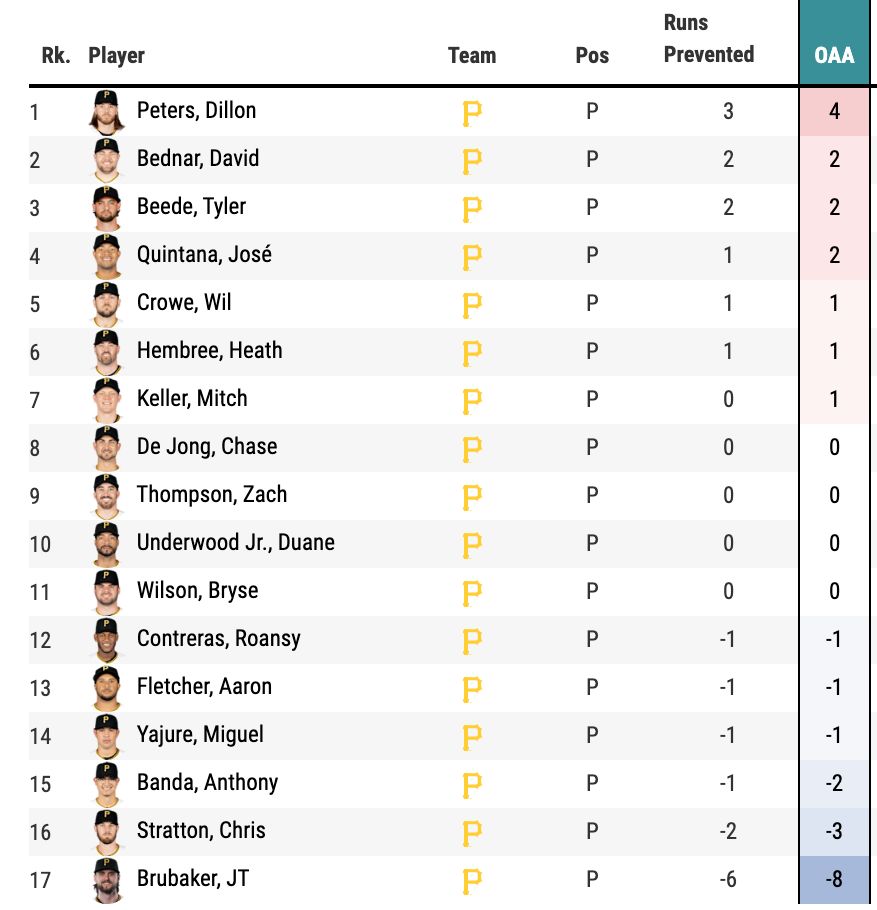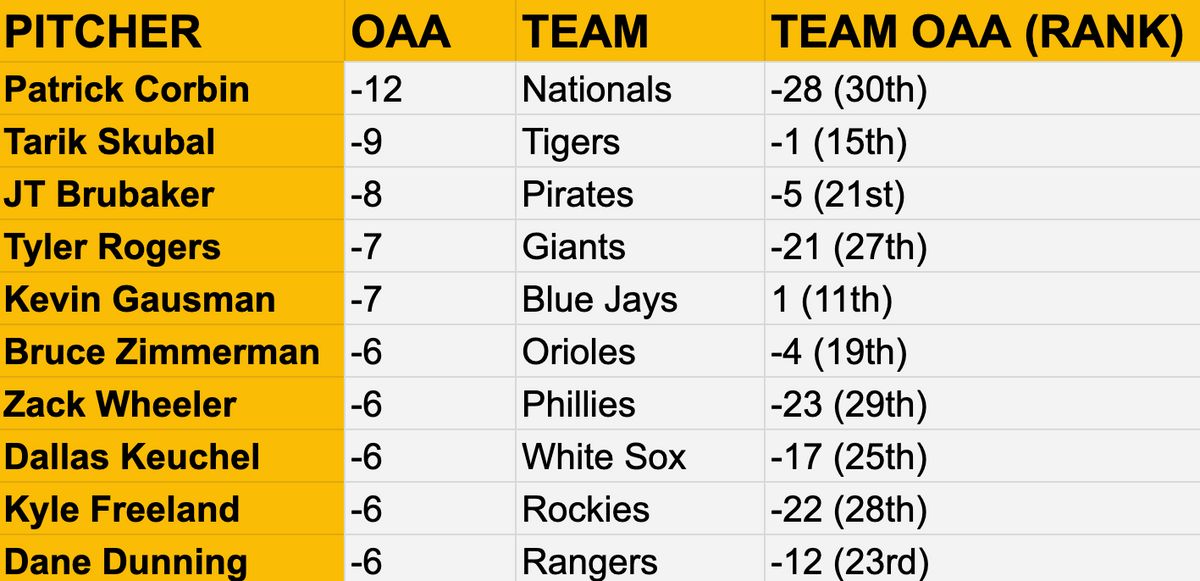ST. LOUIS – It’s been an odd season for JT Brubaker. His selection as the opening day starter was a surprise to many, and now nearly halfway through June, he still doesn’t have a win. That’s not entirely his fault. Many of his early starts were deliberately shortened because of the new hybrid pitcher strategy, so he didn’t even have a shot in a couple games.
He’s also pitched fairly well. If you’re willing to omit his first two starts of the year – which would be spring training starts most seasons anyway – then he has a 3.86 ERA and 4.13 FIP over his last 10 starts. That’s solid enough to stick around in just about any rotation.
But that doesn’t tell the whole story. Brubaker is having a weird year, and a lot of it isn’t his fault. It’s the defense’s.
Fielding analytics are a bit of an imperfect art still when compared to pitching or hitting, but in this reporter’s opinion, the most accurate is Baseball Savant’s Outs Above Average (OAA). The name is self explanatory: Out of the fielding opportunities you have, how many do you convert, and how many do you fail? Going based on the batted ball’s peripherals, an out percentage is applied to it for a fielder. If they convert a routine play, it goes up a little. If they flub it, their OAA takes a big hit. If they fail to make a highlight reel play, it goes down a little. If they convert it, it seriously boosts the OAA.
According to Baseball Savant, the Pirates’ defense has been worth -5 OAA, 21st in baseball. They’re a little below average, but considering they have also made 44 errors, tied for the second-most in baseball, it tells a story of a team that can make some terrific defensive plays, but also occasionally botch an easy one. That’s a pretty common side effect for fielding a young team.
But that’s a very uneven total OAA. When anyone besides Brubaker is on the mound, they’re actually +3 in OAA. When Brubaker, they have -8 OAA. If you want a run total for that, Baseball Savant suggests those extra outs the defense has given up has resulted in six runs against him. Considering Brubaker has allowed eight unearned runs this year, that seams like a reasonable estimate.
For some reason, a slightly above average defense becomes one of the worst in the game when Brubaker is on the rubber.
“That’s how it feels on the field as well,” Michael Chavis responded when I told him about Brubaker’s defensive split. “... I feel like every time I go up to him and tell him, ‘bro, that’s not on you. S— just happens.’ ”
This is, for whatever reason, a Brubaker problem. Looking at the rest of the Pirates’ pitchers, the next closest pitcher to him is Chris Stratton at -3 OAA. With the exception of Dillon Peters (+4 OAA), everyone else falls between +2 of -2 OAA. Or to put it in layman’s terms, a couple errors or web gems away from zero:

BASEBALL SAVANT
Going by OAA, Brubaker has had the third-worst defensive performance of any pitcher in baseball, only ahead of Patrick Corbin of the Nationals (-12) and Tarik Skubal of the Tigers (-9).
Looking at the top 10 pitchers with the worst defensive support, Brubaker’s a bit of an outlier when considering the defense behind him. Here are those 10 pitchers and the 10 teams they play for:

Unsurprisingly, six of the eight worst team defenses have a representative here. The Orioles are basically in the same boat as the Pirates as far as defensive performance goes. So Brubaker, Skubal, Bruce Zimmerman and Kevin Gausman are the only pitchers who have a defense that grades out positively without them on the mound that crack this top 10.
It begs the question, is there anything a pitcher can do to try to get the defense to click behind him? Asking around the clubhouse, no, not really.
“I have zero control over it,” Brubaker said. “Really, the only thing I have control over is throwing then, and even then, when the ball comes out of my hand, it’s not really in my control.”
So what is causing it then? There are theories.
Derek Shelton asked if Brubaker’s own errors contribute to that. Brubaker has already made more errors this season (3) than he did in his first two major-league seasons combined (2), but Baseball Savant does not weigh a pitcher’s own performance behind the plate, nor do they grade the catcher’s. This is about the seven people behind him.
Anthony Banda suggested shifts might have something to do with it. The Pirates do shift with Brubaker (44.3% of plate appearances) than they do in general (36% of PA), but it has mostly worked. The team’s batting average allowed on ground balls when shifting is .211, and just .152 for Brubaker. On all batted balls in play, it’s a .283 BABIP as a team and .256 for Brubaker. OAA also takes a fielder’s starting position into consideration, so if a ball is rolled through the spot they just vacated, they aren’t penalized for it. I don’t think the shift is it.
Chavis wondered if Brubaker creates more defensive opportunities because he throws the sinker. He does, but he’s not the only sinkerballer on the team. In fact, the whole team is throwing more sinkers, as I wrote in this week’s Friday Insider. And that sinker has been good, holding hitters to a .212 average and .283 wOBA. Going by run value, it’s been the 10th-best sinker in baseball this year, being worth -6 runs.
So he’s a sinkerballer who is getting really good results with the sinker, which is normally a pitch you try to get contact with, but the balls that are being put in play aren’t being converted into outs. The deeper we dive into this, the less sense it makes.
Could it just be luck? Maybe, but as Chavis put it, “I feel like we say we’re a little unlucky all the time in baseball, and it does not add up.”
Fair point. One more look before we close the book on this Mound Visit. Baseball Savant breaks down how each position performs behind Brubaker. You’ll never guess who the main two offenders are:

BASEBALL SAVANT
Third base and shortstop. As in Ke’Bryan Hayes and Kevin Newman (and the other roaming shortstops, including the defensively solid Diego Castillo). But that’s a Gold Glove finalist from last year and a future Gold Glove winner. Hayes might even win it this year. On the season, he’s tied with Nolan Arenado and Manny Machado for the most OAA among National League third basemen (5).
But when Brubaker is on the mound, stuff like this tends to happen, for whatever reason:
I did a Mound Visit on Brubaker shortly before the season started where I pointed out that a lot of the batted balls on sinkers went to the left side of the infield. I opined in that piece that his shift in how he attacks with a sinker would mean more ground balls to Hayes and Newman and how “that’s not going to hurt at all.” Somehow it has.
So the question is should we expect Hayes and whoever the shortstop is going forward to play at the pace of two of the worst fielders in baseball when Brubaker is on the mound going forward? I just can’t envision that continuing to happen with Hayes. Brubaker almost has to get better defense behind him.
But I’m here trying to explain something that’s probably unexplainable.
“There is no right answer,” Brubaker said with a shrug. “It’s baseball.”
Seconded. It’s baseball.

